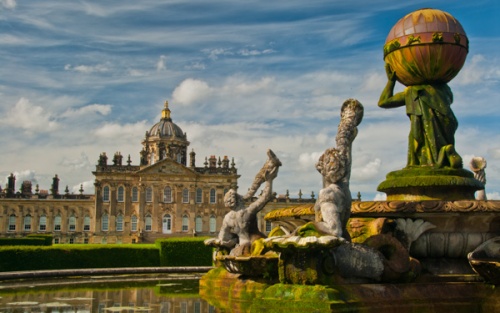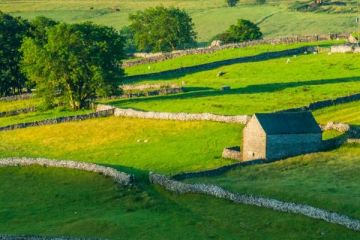
One of the premier stately homes of England, Castle Howard is a baroque masterpiece, more palace than house, conceived by Charles Howard, 3rd Earl of Carlisle, and executed by Sir John Vanbrugh from 1699.
A short drive from the city of York brings you to a long avenue leading to the gates of Castle Howard. The house stands within extensive parkland and formal gardens, where peacocks roam. The setting is idyllic, but it is the house itself that draws the eye.
Castle Howard is centred on a striking dome, with two wings enclosing a courtyard. To the north, the ground falls away to a large lake, to the south, formal gardens share space with more water features and several glorious follies.

HISTORY
The Building of Castle Howard
That the ambitious 3rd Earl of Carlisle should choose to create so extravagant a showpiece home is not so surprising. More surprising by far was his choice of architect.
John Vanbrugh was known in society circles as a young playwright. He had no previous experience of architecture when Charles Howard handed him the commission for his opulent new house. Vanbrugh drew upon the expertise of Nicholas Hawksmoor, the former deputy to Sir Christopher Wren, in carrying out his design at Castle Howard.
At first, this design did not include a central dome; this was added quite late in the construction process. The east wing was completed within 10 years, along with the extraordinary dome. The style was ebullient; carved figures and flowing lines mixed with a panoply of classical elements.
Those classical elements were mixed in unusual fashion; the north front using the Doric order, the south front using Corinthian. When confronted with this oddity, Hawksmoor famously replied that no one could view both fronts at once!
But there was still much to do at Castle Howard; by 1725 Carlisle estimated that he had spent over £78,000 on his house, and it still did not have a west wing to match the east! Part of the delay was due to the Earl's desire to finish the landscaping, a distraction that drew the ire of Vanbrugh, who pleaded with the Earl to complete the west wing. In the end, both men were long dead before the house was complete; Vanbrugh passing in 1726, and the 3rd Earl in 1738.

The task of finishing the west wing fell to the Earl's son-in-law, Sir Thomas Robinson, who did so in the then-popular Palladian style, taking inspiration from William Kent's design for the Houses of Parliament.
Robinson's grand plans called for the interior to be completed to a level of grandeur and convenience that would be unrivalled anywhere in the world, but his grand scheme fell afoul of the young 5th Earl's trustees, who refused to lavish more money on the project. When Robinson died in 1777 the interior was still unfinished, and thus it remained until 1811 when Charles Tatham completed the decoration.

Thus has Castle Howard remained, despite minor alterations over the past several centuries, essentially two unbalanced wings, designed and executed to divergent visions, ranged about a central dome of striking beauty.
That beauty was marred by a devastating fire in 1940, which destroyed the dome and over 20 rooms. For over twenty years the dome was unroofed, but by 1962 repairs had been completed. In the meantime, Castle Howard was opened to the public (1952).
In 1982 the appeal of Castle Howard was further enhanced when it was chosen as the setting for the television production of Evelyn Waugh's novel Brideshead Revisited. A permanent exhibition relating to the filming of the television series can be seen by visitors to the house.
For a closer look at the interior of Castle Howard, with an overview of the major rooms on display to visitors, please see the House section of our Castle Howard Guide. And for a look at the extraordinarily beautiful grounds, visit the Gardens section of this guide.
About Castle Howard
Address: Castle Howard,
York,
Yorkshire,
England, YO60 7DA
Attraction Type: Historic House
Location: 15 m NE York, off A64
Website: Castle Howard
Email: house@castlehoward.co.uk
Historic Houses Association
Location
map
OS: SE716 701
Photo Credit: David Ross and Britain Express
HERITAGE
 We've 'tagged' this attraction information to help you find related historic attractions and learn more about major time periods mentioned.
We've 'tagged' this attraction information to help you find related historic attractions and learn more about major time periods mentioned.
Find other attractions tagged with:
Baroque (Architecture) - castle (Architecture) - Christopher Wren (Person) - John Vanbrugh (Person) - Palladian (Architecture) - William Kent (Person) -
NEARBY HISTORIC ATTRACTIONS
Heritage Rated from 1- 5 (low to exceptional) on historic interest
Bulmer, St Martin's Church - 1.8 miles (Historic Church) ![]()
Appleton-le-Street, All Saints Church - 2.5 miles (Historic Church) ![]()
Barton-le-Street, St Michael's Church - 2.6 miles (Historic Church) ![]()
Amotherby, St Helen's Church - 3 miles (Historic Church) ![]()
Kirkham Priory - 3 miles (Abbey) ![]()
Slingsby, All Saints Church - 3.2 miles (Historic Church) ![]()
Crambe, St Michael's Church - 3.4 miles (Historic Church) ![]()
Sheriff Hutton Church - 4.3 miles (Historic Church) ![]()













